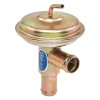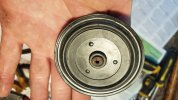keynsham1
Active Member
So the inevitable has finally happened. After my trip back from the NEC Classic car show, and the first time I have used the heater in years, a small puddle of coolant has appeared on the garage floor and for those with a NADA car, you will not be surprised to hear it is the Ranco heater valve that is the culprit. Some years ago, I was lucky enough to find a second hand one which I needed when my original decided to leak the entire contents of the coolant system on the floor. So, the replacement has also given up now, so I need to replace it.
My question is if I replace it with the usual option of the Jensen one, or the one in the picture, which don't have the capillary, then I assume it will all work fine except for the climate 'control' function which is supposed to keep the cabin at a constant temperature? TO be honest, this function did seem to be hopeless in reality as when driving back the car seemed to be nice and warm and then become quite cold. I am not really interested in the control part; I just want the heater to work and the coolant to stay in the engine!!
Interestingly, Martin Robey sells the Interceptor replacement and comment on the lack of capillary attachment in their advert! Also, in their advert it shows a picture from the Interceptor parts book which shows the valve looks very much like the original Rover valve!!Lastly, the same make part is only £23 on Amazon!!!

My question is if I replace it with the usual option of the Jensen one, or the one in the picture, which don't have the capillary, then I assume it will all work fine except for the climate 'control' function which is supposed to keep the cabin at a constant temperature? TO be honest, this function did seem to be hopeless in reality as when driving back the car seemed to be nice and warm and then become quite cold. I am not really interested in the control part; I just want the heater to work and the coolant to stay in the engine!!
Interestingly, Martin Robey sells the Interceptor replacement and comment on the lack of capillary attachment in their advert! Also, in their advert it shows a picture from the Interceptor parts book which shows the valve looks very much like the original Rover valve!!Lastly, the same make part is only £23 on Amazon!!!









